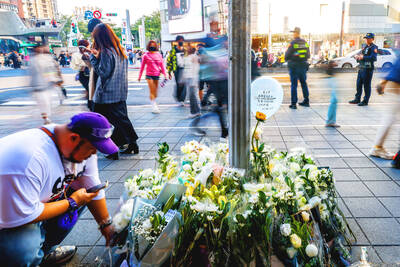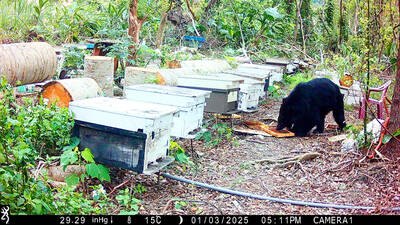If you still think the term "low carb" refers to "low carbohydrate" -- a dieting tactic that cuts calories by staying away from bread and pasta -- then think again.
The new "low carb" that everyone is talking about is "low carbon emission."
From former US vice president Al Gore to the Kyoto Protocol that covers more than 170 countries; from the anti-global warming parade in Taipei earlier this month to the UN conference on Indonesia's Bali Island, the term refers to activities that emit relatively little carbon dioxide.
While the term may make the average Joe feel distanced, befuddled or even intimidated, the issue at hand in fact affects every one of us, Financial Times environmental correspondent Fiona Harvey said at a climate change seminar in Taipei earlier this month.
Skeptics who insist that climate change is due to natural climatic variations draw from a limited scientific basis, "like doctors who claim AIDS can be cured by herbal remedies," Harvey said.
Green Party Taiwan Secretary-General Pan Han-shen (潘翰聲) said that carbon dioxide is the number one contributor to greenhouse gas, the main culprit for global warming.
Citing the UN's Intergovernmental Panel on Climate Change, Pan said that global warming will increase the world's temperature by 1.1oC to 6.4oC this century, raising the sea level between 18cm and 59cm.
Power and oil companies are the largest carbon emitters, he said, claiming that the Formosa Plastic Group is responsible for a quarter of greenhouse gas emissions in Taiwan.
In European countries, there is a trend of consumers choosing to buy higher-priced, but more environmentally friendly products, said Frederic Laplanche, deputy head of office at the European Economic and Trade Office, at a conference in Taipei earlier this month.
Businesses exist due to the supply and demand of the market, he said.
"As a consumer, you have the power to determine market needs," he said.
To live a low-carb lifestyle in terms of emissions as well as food boils down to simple mathematics, Harvey said.
A National Geographic study found that a computer that is on stand-by wastes enough energy in one night to print 10,000 pages of documents.
Taiwanese consumed 181.6 billion units of electricity last year, Taipower Company statistics show.
Up to 11 percent of the electricity consumed in advanced countries is wasted on appliances standing by, an International Energy Agency study said.
If one punches in the numbers, the 11 percent of electricity wasted last year translated to 123 million tonnes of carbon dioxide unnecessarily emitted.
"The average consumer may not know that by unplugging cellphone chargers and computers when they are not in use, they can save an immense amount of carbon emissions," Harvey said.
The same National Geographic study said that if one takes note of "food miles," the distance that food had to travel to get to the table, importing a kiwi fruit from New Zealand emits as much carbon dioxide as five times the fruit's weight.
A kiwi fruit traveling from southern Taiwan emits hardly a fraction of that number, not to mention one's potential savings on price, the study said.
To calculate one's own carbon emissions, Harvey recommended a number of online greenhouse gas calculators, like the one found on the "Cool Taiwan" Web site for the Environmental Quality Protection Foundation.
For example, to travel 20km in Taipei in a mid-sized sedan emits 4.43kg of carbon dioxide, the calculator said. If one takes the bus, the number is a mere 0.74kg, it said.
Of course, if one walks or bikes, the number is zero.
While flying domestically may produce as little as 3kg of carbon dioxide, international flights to the US or Europe may produce as much as 52kg, the calculator said.
"With global warming, people need to feel the extent of the problem and be offered viable solutions," Harvey said, adding that education on the matter and solution formation are equally important.
Last month, US-born Taiwanese nationa, Robin Winkler, who is a lawyer, urged his employees to do their leisure traveling domestically, saying that it was more environmental friendly and fosters an appreciation in people for local culture and scenery.
But living a low-carb life does not stop at food, travel or turning off your VCR, he said.
"Living a low-carb lifestyle is to always ponder whether [your carbon-emitting activities] are necessary," Winkler said at the time, calling the notion "living mindfully," a concept borrowed from Buddhism.
Small changes go a long way in many aspects.
According to a Taipei City Government study, if one installs a water saving o-ring in the faucet, one can shave up to 70 percent off the water bill.
A National Geographic study also suggests that if one puts a lid on the pot when simmering, one can save up to 90 percent of the energy used for cooking. The Cool Taiwan calculator also indicates that one person living in Taipei can neutralize 532kg of carbon -- the city's average monthly emission per person -- by planting 40 trees.
"While your actions may seem trivial, the power of collective action is grand," Harvey was quoted as saying at the seminar.
To do your own calculations visit www.envi.org.tw/cooltaiwan/calculator_01.html.

SHIPS, TRAINS AND AUTOMOBILES: The ministry has announced changes to varied transportation industries taking effect soon, with a number of effects for passengers Beginning next month, the post office is canceling signature upon delivery and written inquiry services for international registered small packets in accordance with the new policy of the Universal Postal Union, the Ministry of Transportation and Communications said yesterday. The new policy does not apply to packets that are to be delivered to China, the ministry said. Senders of international registered small packets would receive a NT$10 rebate on postage if the packets are sent from Jan. 1 to March 31, it added. The ministry said that three other policies are also scheduled to take effect next month. International cruise ship operators

HORROR STORIES: One victim recounted not realizing they had been stabbed and seeing people bleeding, while another recalled breaking down in tears after fleeing A man on Friday died after he tried to fight the knife-wielding suspect who went on a stabbing spree near two of Taipei’s busiest metro stations, Taipei Mayor Chiang Wan-an (蔣萬安) said. The 57-year-old man, identified by his family name, Yu (余), encountered the suspect at Exit M7 of Taipei Main Station and immediately tried to stop him, but was fatally wounded and later died, Chiang said, calling the incident “heartbreaking.” Yu’s family would receive at least NT$5 million (US$158,584) in compensation through the Taipei Rapid Transit Corp’s (TRTC) insurance coverage, he said after convening an emergency security response meeting yesterday morning. National

PLANNED: The suspect visited the crime scene before the killings, seeking information on how to access the roof, and had extensively researched a 2014 stabbing incident The suspect in a stabbing attack that killed three people and injured 11 in Taipei on Friday had planned the assault and set fires at other locations earlier in the day, law enforcement officials said yesterday. National Police Agency (NPA) Director-General Chang Jung-hsin (張榮興) said the suspect, a 27-year-old man named Chang Wen (張文), began the attacks at 3:40pm, first setting off smoke bombs on a road, damaging cars and motorbikes. Earlier, Chang Wen set fire to a rental room where he was staying on Gongyuan Road in Zhongzheng District (中正), Chang Jung-hsin said. The suspect later threw smoke grenades near two exits

The Forestry and Nature Conservation Agency yesterday launched a gift box to market honey “certified by a Formosan black bear” in appreciation of a beekeeper’s amicable interaction with a honey-thieving bear. Beekeeper Chih Ming-chen (池明鎮) in January inspected his bee farm in Hualien County’s Jhuosi Township (卓溪) and found that more than 20 beehives had been destroyed and many hives were eaten, with bear droppings and paw prints near the destroyed hives, the agency said. Chih returned to the farm to move the remaining beehives away that evening when he encountered a Formosan black bear only 20m away, the agency said. The bear